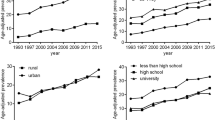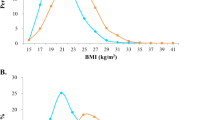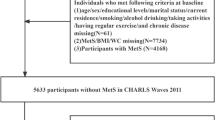Abstract
Background/objectives
An increase in mean body mass index (BMI) or prevalence of obesity may be accompanied by changes in the population BMI distribution. This study aimed to examine how the distributions of BMI and waist circumference (WC) have changed in South Korea over a 16-year interval (1998–2014).
Subjects/methods
Using the Korea National Health and Nutrition Examination Survey, we analyzed changes in mean, standard deviation (SD), 5th, and 95th percentile values of BMI and WC distributions for 46,343 (BMI) and 46,327 (WC) adults aged 25–64 years.
Results
For men, mean BMI increased at an annual rate of 0.060 units (95% CI: 0.047–0.073) with annual increases of 0.029 units in SD (95% CI: 0.019–0.039), 0.121 units in the 95th percentile (95% CI: 0.097–0.145) and 0.042 units in the 5th percentile (95% CI: 0.021–0.062). The 95th percentile and SD of the WC distribution increased, but not mean WC and the 5th percentile. For women, mean BMI decreased at an annual rate of 0.030 units (95% CI: 0.010–0.049) with a 0.030-unit increase in SD (95% CI: 0.012–0.048) and a 0.049-unit decrease in the 5th percentile (95% CI: 0.029–0.070). Mean WC also decreased with an increase in SD and a decrease in the 5th percentile.
Conclusions
These findings suggest increasing dispersion in the distribution of BMI and WC derived from significant shifts in the upper tails for Korean men, but not women. Future research needs to identify the factors that underlie the increasing dispersion of obesity measures.
This is a preview of subscription content, access via your institution
Access options
Subscribe to this journal
Receive 12 print issues and online access
$259.00 per year
only $21.58 per issue
Buy this article
- Purchase on Springer Link
- Instant access to full article PDF
Prices may be subject to local taxes which are calculated during checkout


Similar content being viewed by others
References
Ng M, Fleming T, Robinson M, Thomson B, Graetz N, Margono C, et al. Global, regional, and national prevalence of overweight and obesity in children and adults during 1980–2013: a systematic analysis for the Global Burden of Disease Study. Lancet. 2013;384:766–81.
NCD Risk Factor Collaboration. Trends in adult body-mass index in 200 countries from 1975 to 2014: a pooled analysis of 1698 population-based measurement studies with 19.2 million participants. Lancet. 2016;387:1377–1396.
Peeters A, Gearon E, Backholer K, Carstensen B. Trends in the skewness of the body mass index distribution among urban Australian adults, 1980 to 2007. Ann Epidemiol. 2015;25:26–33.
Flegal KM, Carroll MD, Kit BK, Ogden CL. Prevalence of obesity and trends in the distribution of body mass index among US adults, 1999-2010. JAMA. 2012;307:491–7.
Hayes A, Gearon E, Backholer K, Bauman A, Peeters A. Age-specific changes in BMI and BMI distribution among Australian adults using cross-sectional surveys from 1980 to 2008. Int J Obes. 2015;39:1209–16.
Green MA, Subramanian SV, Razak F. Population-level trends in the distribution of body mass index in England, 1992-2013. J Epidemiol Community Health. 2016;70:832–5.
Krishna A, Razak F, Lebel A, Smith GD, Subramanian SV. Trends in group inequalities and interindividual inequalities in BMI in the United States, 1993-2012. Am J Clin Nutr. 2015;101:598–605.
Ljungvall Å, Zimmerman FJ. Bigger bodies: Long-term trends and disparities in obesity and body-mass index among U.S. adults, 1960–2008. Soc Sci Med. 2012;75:109–19.
Tatsumi Y, Ohno Y, Morimoto A, Nishigaki Y, Mizuno S, Watanabe S. BMI percentile curves for Japanese men and women aged 20-79 years who underwent a health check-up in 1980 and 2005. Obes Res Clin Pract. 2013;7:e401–406.
Ouyang Y, Wang H, Su C, Wang Z, Song Y, Xiao Y, et al. Use of quantile regression to investigate changes in the body mass index distribution of Chinese adults aged 18-60 years: a longitudinal study. BMC Public Health. 2015;15:278.
Khang YH, Yun SC. Trends in general and abdominal obesity among Korean adults: findings from 1998, 2001, 2005, and 2007 Korea National Health and Nutrition Examination Surveys. J Korean Med Sci. 2010;25:1582–8.
Kweon S, Kim Y, Jang M-j, Kim Y, Kim K, Choi S, et al. Data resource profile: the Korea National Health and Nutrition Examination Survey (KNHANES). Int J Epidemiol. 2014;43:69–77.
Ogden CL, Yanovski SZ, Carroll MD, Flegal KM. The epidemiology of obesity. Gastroenterology. 2007;132:2087–102.
Sorkin JD, Muller DC, Andres R. Longitudinal change in height of men and women: implications for interpretation of the body mass index: the Baltimore Longitudinal Study of Aging. Am J Epidemiol. 1999;150:969–77.
Razak F, Corsi DJ, Subramanian SV. Change in the body mass index distribution for women: analysis of surveys from 37 low- and middle-income countries. PLoS Med. 2013;10:e1001367.
Baum CF. Stata tip 38: testing for groupwise heteroskedasticity. Stata J. 2006;6:590–2.
Lahti-Koski M, Vartiainen E, Männistö S, Pietinen P. Age, education and occupation as determinants of trends in body mass index in Finland from 1982 to 1997. Int J Obes. 2000;24:1669–76.
Monteiro CA, D'A Benicio MH, Conde WL, Popkin BM. Shifting obesity trends in Brazil. Eur J Clin Nutr. 2000;54:342–6.
Maruyama S, Nakamura S. The decline in BMI among Japanese women after World War II. Econ Human Biol. 2015;18:125–38.
Kang HT, Shim JY, Lee HR, Park BJ, Linton JA, Lee YJ. Trends in prevalence of overweight and obesity in Korean adults, 1998-2009: the Korean National Health and Nutrition Examination Survey. J Epidemiol. 2014;24:109–16.
Lee HK, Chou SP, Cho MJ, Park J-I, Dawson DA, Grant BF. The prevalence and correlates of alcohol use disorders in the United States and Korea—a cross-national comparative study. Alcohol. 2010;44:297–306.
Rosenquist JN, Lehrer SF, O’Malley AJ, Zaslavsky AM, Smoller JW, Christakis NA, Cohort of birth modifies the association between FTO genotype and BMI. Proc Natl Acad Sci USA. 2015;112:354–9.
Demerath EW, Choh AC, Johnson W, Curran JE, Lee M, Bellis C, et al. The positive association of obesity variants with adulthood adiposity strengthens over an 80-year period: a gene-by-birth year interaction. Hum Hered. 2013;75:175–85.
Young AI, Wauthier F, Donnelly P. Multiple novel gene-by-environment interactions modify the effect of FTO variants on body mass index. Nat Commun. 2016;7:12724.
Walter S, Mejia-Guevara I, Estrada K, Liu SY, Glymour MM. Association of a genetic risk score with body mass index across different birth cohorts. JAMA. 2016;316:63–69.
Choi OJE, Cho YG, Kang JH, Park HA, Kim KW, Hur YI, et al. Weight control attempts in underweight Korean adults: Korea National Health and Nutrition Examination Survey, 2007–10. Korean J Family Med. 2013;34:393–402.
Chen H, Jackson T. Prevalence and sociodemographic correlates of eating disorder endorsements among adolescents and young adults from China. Eur Eat Disord Rev. 2008;16:375–85.
Lee M-J, Popkin BM, Kim S. The unique aspects of the nutrition transition in South Korea: the retention of healthful elements in their traditional diet. Public Health Nutr. 2002;5:197–203.
Kim S, Moon S, Popkin BM. The nutrition transition in South Korea. Am J Clin Nutr. 2000;71:44–53.
Bates LM, Acevedo-Garcia D, Alegria M, Krieger N. Immigration and generational trends in body mass index and obesity in the United States: results of the National Latino and Asian American Survey, 2002–3. Am J Public Health. 2008;98:70–77.
Sanchez-Vaznaugh EV, Kawachi I, Subramanian SV, Sanchez BN, Acevedo-Garcia D. Differential effect of birthplace and length of residence on body mass index (BMI) by education, gender and race/ethnicity. Soc Sci Med. 2008;67:1300–10.
Lauderdale DS, Rathouz PJ. Body mass index in a US national sample of Asian Americans: effects of nativity, years since immigration and socioeconomic status. Int J Obes Relat Metab Disord. 2000;24:1188–94.
Albrecht SS, Gordon-Larsen P. Ethnic differences in body mass index trajectories from adolescence to adulthood: a focus on hispanic and Asian subgroups in the United States. PLoS ONE. 2013;8:e72983.
Ministry of Health and Welfare of Korea, Korea Centers for Disease Control & Prevention. Manual for Korea National Health and Nutrition Examination Survey. Korea Centers for Disease Control & Prevention: Osong, 2015.
Author information
Authors and Affiliations
Corresponding author
Ethics declarations
Conflict of interest
The authors declare that they have no competing interests.
Electronic supplementary material
Rights and permissions
About this article
Cite this article
Kim, S., Subramanian, S.V., Oh, J. et al. Trends in the distribution of body mass index and waist circumference among South Korean adults, 1998–2014. Eur J Clin Nutr 72, 198–206 (2018). https://doi.org/10.1038/s41430-017-0024-7
Received:
Revised:
Accepted:
Published:
Issue Date:
DOI: https://doi.org/10.1038/s41430-017-0024-7



